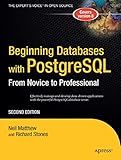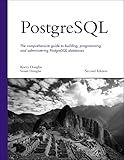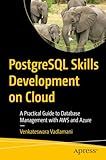Best Tools and Books to Buy in December 2025

PostgreSQL 16 Administration Cookbook: Solve real-world Database Administration challenges with 180+ practical recipes and best practices



Beginning Databases with PostgreSQL: From Novice to Professional (Beginning From Novice to Professional)
- AFFORDABLE PRICES FOR QUALITY USED BOOKS-SAVE MONEY TODAY!
- CAREFULLY INSPECTED FOR GOOD CONDITION-READ WITH CONFIDENCE.
- WIDE SELECTION ACROSS GENRES-FIND YOUR NEXT FAVORITE READ!



PostgreSQL
- AFFORDABLE OPTION-GREAT SAVINGS ON QUALITY LITERATURE!
- ECO-FRIENDLY CHOICE-GIVE BOOKS A SECOND LIFE!
- RIGOROUSLY INSPECTED-ENSURES QUALITY DESPITE PREVIOUS USE!



PostgreSQL Skills Development on Cloud: A Practical Guide to Database Management with AWS and Azure



Mastering PostgreSQL 11: Expert techniques to build scalable, reliable, and fault-tolerant database applications, 2nd Edition


Deadlock in PostgreSQL occurs when two or more transactions are waiting for each other to release a lock on a resource. It happens when two transactions have locked resources in a way that each transaction is waiting for the other to release the lock, causing a deadlock situation.
To avoid deadlocks in PostgreSQL, you can follow some best practices:
- Always access tables and rows in the same order: To prevent deadlocks, make sure that all transactions access tables and rows in the same order to avoid circular dependencies.
- Keep transactions short and efficient: Long-running transactions increase the likelihood of deadlocks, so try to keep your transactions as short and efficient as possible.
- Use the appropriate isolation level: When defining your transactions, use the appropriate isolation level to minimize the chances of deadlock. This includes using Read Committed or Serializable isolation levels.
- Use indexes effectively: Properly indexing your tables can improve query performance and reduce the chances of deadlocks by minimizing the time other transactions need to wait for a lock.
- Monitor and analyze deadlock situations: Monitor your database for deadlock situations and analyze the root cause to identify any recurring issues. This will help you identify and address potential problem areas before they lead to deadlocks.
By following these best practices, you can minimize the chances of encountering deadlocks in PostgreSQL and ensure the smooth operation of your database system.
How to test for deadlock scenarios in PostgreSQL?
One way to test for deadlock scenarios in PostgreSQL is to intentionally create a situation where two or more transactions are trying to access resources (such as rows in a table) in a conflicting order. This can be done by writing a script that starts two transactions and has them update the same rows in a different order.
Alternatively, you can use the pg_test_fsync tool in PostgreSQL to simulate a deadlock scenario. This tool allows you to test how database operations behave under various failure scenarios, including deadlock situations.
You can also enable logging of deadlock events in the PostgreSQL server by setting the log_lock_waits and log_min_duration_statement parameters in the [postgresql](https://elvanco.com/blog/how-to-connect-postgresql-to-java).conf file. This will allow you to monitor the server logs for any deadlock events that occur during testing.
Overall, the key to testing for deadlock scenarios in PostgreSQL is to create situations where multiple transactions are contending for the same resources in conflicting orders, and to monitor the server logs for any deadlock events that may occur.
How to design database queries to avoid deadlock in PostgreSQL?
- Use proper indexing: Make sure that the tables involved in the query have appropriate indexes created on the columns being used in the query. This can help PostgreSQL to retrieve the necessary data efficiently and reduce the chance of deadlock.
- Use proper transaction management: Properly manage transactions by opening and closing them at the right time. Use BEGIN and COMMIT/ROLLBACK statements to start and end transactions, and avoid running long-running transactions that could potentially cause deadlocks.
- Use SELECT FOR UPDATE: When updating or deleting rows in a table, use the SELECT FOR UPDATE statement to lock the rows before making changes. This can help prevent other transactions from accessing or updating the same rows simultaneously and causing a deadlock.
- Use a consistent order for accessing resources: If multiple transactions need to access the same resources, make sure they do so in a consistent order to prevent deadlocks. For example, if one transaction always accesses resources A, B, and C in that order, another transaction should also follow the same order when accessing those resources.
- Use explicit locking: If necessary, use explicit locking mechanisms such as advisory locks or row-level locks to prevent conflicting operations between transactions and avoid deadlocks.
- Monitor for deadlock conflicts: Set up monitoring tools to identify and resolve deadlock conflicts quickly. PostgreSQL provides utilities like pg_stat_activity and pg_locks to monitor and analyze deadlock situations.
- Use appropriate isolation levels: Choose the appropriate isolation level for your transactions based on your application's requirements. The default isolation level in PostgreSQL is READ COMMITTED, but you can also use higher isolation levels like REPEATABLE READ or SERIALIZABLE to prevent concurrency issues and deadlocks.
By following these best practices and guidelines, you can design database queries in PostgreSQL that minimize the risk of deadlocks and ensure smooth and efficient transaction processing.
What is a deadlock in PostgreSQL?
In PostgreSQL, a deadlock occurs when two or more transactions are waiting for each other to release locks on rows or tables, preventing them from proceeding further. This can happen when one transaction holds a lock on a resource needed by another transaction, and vice versa, resulting in a "deadly embrace" where neither transaction can continue.
PostgreSQL has built-in deadlock detection mechanisms that can identify and resolve deadlocks by automatically canceling one of the transactions involved. However, it is important for developers and database administrators to design their queries and transactions in a way that minimizes the likelihood of deadlocks occurring.
What is the relationship between transaction dependencies and deadlock in PostgreSQL?
Transaction dependencies and deadlocks are closely related concepts in PostgreSQL, as transaction dependencies can be a contributing factor to deadlock situations.
In PostgreSQL, transactions can be dependent on each other if they are trying to access the same resources, such as table rows or database objects. When two transactions try to access the same resource at the same time, one transaction may need to wait for the other to release the resource, creating a dependency between the two transactions.
If multiple transactions are dependent on each other and also require exclusive access to resources, deadlock can occur. Deadlock happens when two or more transactions are waiting for each other to release resources, resulting in a deadlock situation where none of the transactions can proceed.
To prevent deadlock in PostgreSQL, it is important to carefully manage transaction dependencies by minimizing the time transactions hold locks on resources and avoiding circular dependencies between transactions. It is also important to write efficient queries and use appropriate locking mechanisms to minimize the chances of deadlock occurring.
What is the impact of high concurrency on deadlock handling in PostgreSQL?
High concurrency can have a significant impact on deadlock handling in PostgreSQL. When multiple transactions are running concurrently and accessing the same resources, the likelihood of deadlocks occurring increases. Deadlocks occur when two or more transactions are waiting for each other to release locks on resources, resulting in a deadlock situation where neither transaction can proceed.
In PostgreSQL, deadlocks are detected by the database's deadlock detection mechanism, which identifies and resolves deadlock situations by rolling back one of the transactions involved in the deadlock. When there are high levels of concurrency, the frequency of deadlock occurrences may increase, leading to more frequent transaction rollbacks and potential performance degradation.
In order to mitigate the impact of high concurrency on deadlock handling in PostgreSQL, it is important to properly design the database schema and application logic to minimize the likelihood of deadlock situations. This can be achieved by carefully designing transaction isolation levels, using appropriate locking strategies, and ensuring that transactions are kept as short and as efficient as possible.
Additionally, monitoring and tuning database performance and concurrency settings can help to optimize deadlock detection and resolution in PostgreSQL. By closely monitoring database performance metrics and tuning configuration parameters such as deadlock_timeout and max_connections, administrators can improve the database's ability to handle high concurrency and prevent deadlock situations from occurring.
